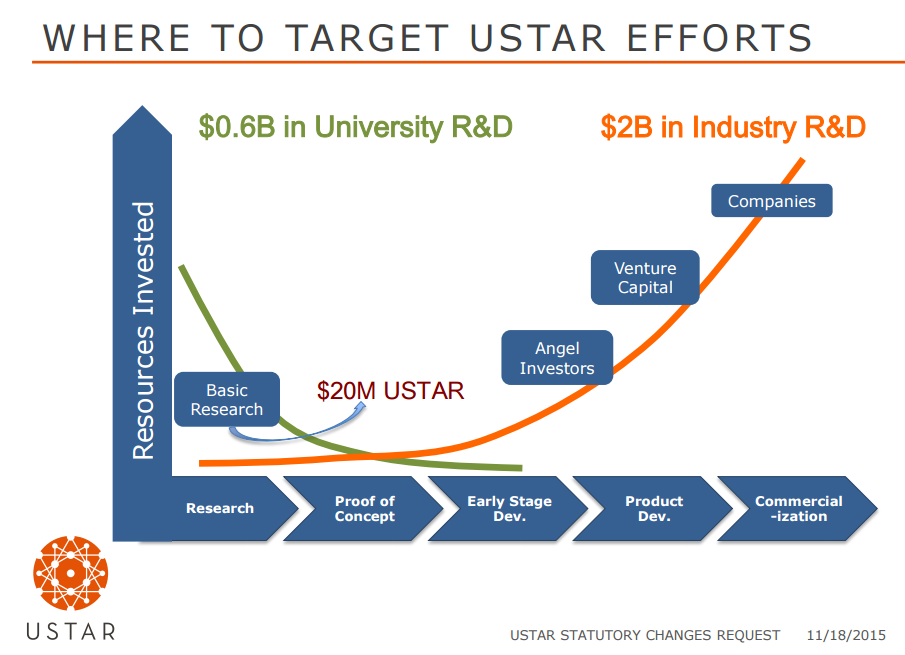Fiscal Highlights - November 2015
|
USTAR's Proposed Budget Changes -
Clare Tobin Lence ( The Utah Science Technology and Research (USTAR) Initiative has undergone budget reorganizations in the 2014 and 2015 General Sessions, following legislative audits. Currently, funding is allocated across three line items: USTAR Administration, Technology Outreach and Innovation, and University Research Teams. USTAR has proposed statutory changes for the 2016 General Session that would further modify its budget structure, based on a recent assessment by outside consultants. The first proposed change addresses funding of university research teams. Prior to FY 2015, research team funding was allocated 60 percent to the University of Utah and 40 percent to Utah State University. Starting in FY 2015, funding was appropriated by research team -- of which there are 12 at the University of Utah and five at Utah State University -- allowing more flexibility for USTAR to adjust funding based on team performance, rather than a default allocation. For the 2016 General Session, USTAR has proposed allowing other state universities to compete for research funding that was not previously committed to USTAR faculty. The proposal would reduce the percentage of total USTAR funding going to university research from 82 percent to 50 percent. Funding reduced from university research would be reallocated to the Technology Outreach and Innovation Program (TOIP), increasing TOIP funding to 45 percent of USTAR's total budget. TOIP would offer new programs, such as pre-seed funding to support early stage companies through the "valley of death" -- the point in between basic research funding and angel investing, where many fledgling companies fail. TOIP would also work to develop new industry partnerships to align researchers with the needs of Utah's main industries.  Figure 1: USTAR proposes targeting funding where the green curve (representing basic research funding) and the orange curve (representing private investment) are both low; this "valley of death" is a point at which many early-stage companies fail due to limited funding opportunities. Total funding for USTAR, as well as funding for the Administration line item, would remain the same. USTAR anticipates that these changes would clarify USTAR's mission as an economic development organization rather than simply a source of research funding, and accelerate return on investment to the State by supporting and investing in technologies and companies that are closer to successful operation. |
A Look at the Change in Utah's 2015 Unemployment Rate Compared to Other States - Thomas E. Young The unemployment rate in Utah is one of the lowest in the country at 3.6%. Based on the most ...Corrections' Populations Status November 2016 - Gary R. Syphus The main cost drivers of the Department of Corrections are the (1) prison population and (2) adult ...Division of Fleet Operations General Fund Borrowing - Brian Wikle The Division of Fleet Operations was established as an internal service fund (ISF) in FY 1997. ...Fall Enrollment on the Upswing in Higher Education - Spencer C. Pratt The Utah System of Higher Education experienced an increase of 2,775 Budget-Related FTE students fo...Medicaid Costs Projected to Rise - Russell T. Frandsen Medicaid - What is Included in Consensus for Mandatory Costs? The Medicaid forecast te...Performance Note Improvements in Six Easy Steps - Steven M. Allred Most of us have become familiar with performance notes since a rule change in the 2011 General Sess...Phragmites Control on the Great Salt Lake - Ivan D. Djambov The Division of Forestry, Fire, and State Lands is continuing to work on phragmites control on sove...Taking the Game Out of Salary and Related Benefit Budget Estimates - Stephen C. Jardine Prior to 2012 the possibility existed that an agency could estimate the salary and related benefi...USTAR's Proposed Budget Changes - Clare Tobin Lence The Utah Science Technology and Research (USTAR) Initiative has undergone budget reorganizations ... |
Reports/Archive | Budget Process | Office Background | Who's Who | Organization Chart
Office of the Legislative
Fiscal Analyst
House Building, Suite W310
Salt Lake City, UT 84114
Phone (801) 538-1034 Fax (801) 538-1692